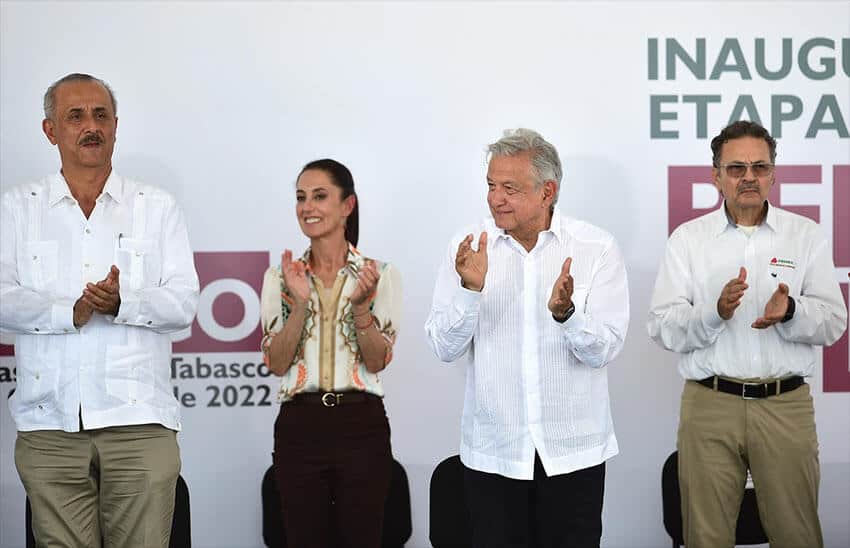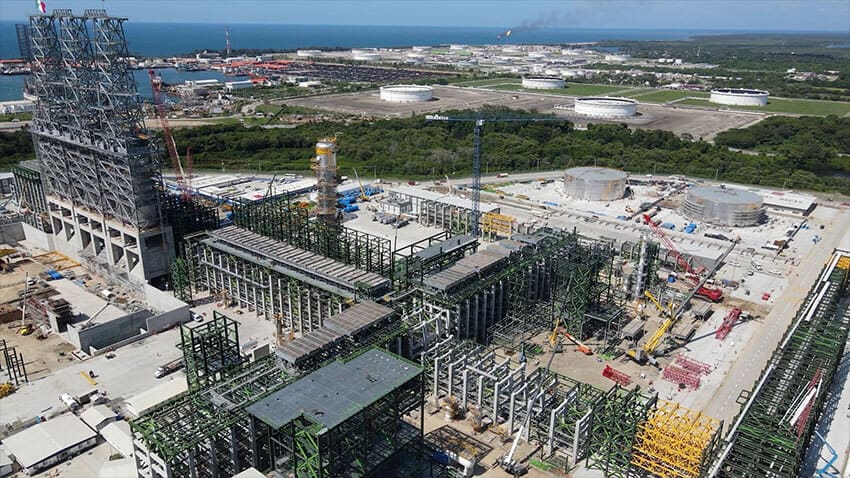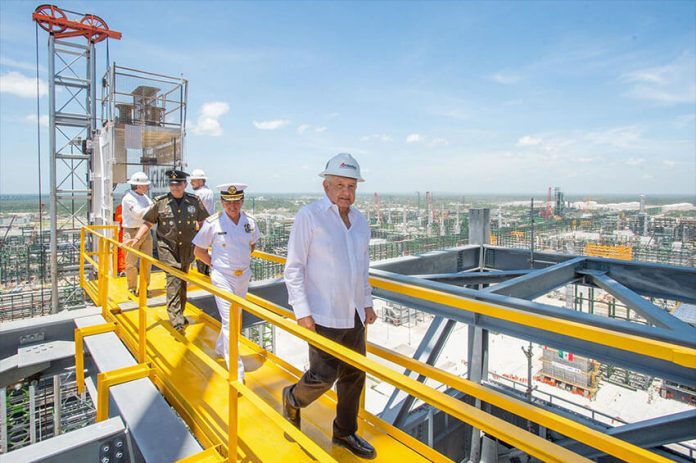President López Obrador on Friday officially opened the new Pemex refinery on the Gulf coast of Tabasco, even though the facility is unfinished and not expected to begin refining oil until late 2023 at the earliest.
Despite that, AMLO declared that the inauguration of the Dos Bocas refinery – officially called the Olmeca Refinery – is “a dream come true.”
The refinery, whose final cost could balloon to as much as US $18 billion, is the first to be built in Mexico since the 1970s. Once fully operational, it will process 340,000 barrels of crude per day, a capacity that will increase national output by 20% and which López Obrador says will allow Mexico to become self-sufficient for fuel and protect itself from global volatility.
“We’re getting ready to stop importing gasoline, diesel and jet fuel, in order to be self-sufficient, create employment in the country, and direct these fuels to the internal market and national development,” he said Friday during an opening ceremony attended by cabinet ministers, Pemex CEO Octavio Romero and prominent business figures such as billionaire Carlos Slim.

“… This is a moment of big change, a major turn, from selling crude oil to transforming the raw material, producing the fuel ourselves, and selling it on the internal market,” AMLO said.
In building the refinery, the president boasted, “we didn’t pay attention to the siren calls, the voices that predicted, perhaps in good faith, that the oil era was over, and that electric cars and renewable energy were arriving en masse.”
Such a scenario if still a long way off in Mexico, AMLO asserted. The president railed against his “neoliberal” predecessors’ management of the national oil sector, which has long been an important source of government revenue even as Mexico imported large quantities of fuels from the United States.
“They bet on selling crude and buying [fuel] abroad. The leaders sought to destroy the national oil industry. They left the six refineries in a deplorable state,” said López Obrador, whose government is upgrading the existing refineries and purchased Shell’s 50% stake in a Texas refinery that company owned with Pemex.
AMLO has set a goal of achieving self-sufficiency for fuel by 2023, but that timetable could be difficult to meet given that that Dos Bocas – which according to the news agency Bloomberg looks more like a tech campus than a place where dirty crude is processed – might not even begin refining oil next year. According to experts cited by the newspaper El País, the refinery won’t start producing gasoline until the end of 2023 or early 2024. A lengthy period of testing – up to nine months – is needed before extensive refining can begin, and that can’t commence until construction is completed.
Energy Minister Rocío Nahle declared that the refinery has “the most modern technology in the world,” but it can’t yet be put to proper use as the different plants of the facility are not connected to each other. Two people with knowledge of the refinery project told the news agency Reuters that it will be 2025 – after López Obrador has left office – before the refinery will be working at near capacity.
Oscar Ocampo, an energy expert with the Mexican Institute for Competitiveness (IMCO), a think tank, said before Friday’s inauguration that there was a lack of information about the progress that has been made on building the refinery and when it will be operational.
There have been no public responses to basic questions about the project, he told the newspaper El Financiero. “We’re going to see the cutting of a ribbon and a government report, but we don’t know what’s behind [the ribbon] and this is very concerning given that it’s one of this administration’s priority projects,” Ocampo said.

Gonzalo Monroy, an energy analyst and consultant, described the new refinery as a “monument to opacity,” built according to political rather than technical specifications. “To add more layers of opacity, the government used affiliated companies of Pemex” whose work isn’t easy to oversee or evaluate from an accountability point of view, he said.
The refinery was developed by PTI Infraestructura de Desarollo, an affiliate of the state oil company. IMCO said in a note that affiliated companies, unlike subsidiaries of Pemex, “operate under private law and therefore don’t have the same transparency and contracting obligations.”
Meanwhile, Arturo Carranza, an energy expert, predicted that the useful lifespan of the Dos Bocas refinery will be short given that a transition to renewable energy is underway.
But López Obrador, a staunch energy nationalist who was born and raised in oil-rich Tabasco, believes that the heyday of fossil fuels is not yet over, at least in Mexico. In addition to betting big on the oil sector with the construction of the new refinery, his government has made it difficult for private renewable companies to operate in Mexico – although such firms breathed a sigh of relief when an electricity reform that would have guaranteed the state owned Federal Electricity Commission over half the market failed to pass Congress in April.
Analysts have questioned the wisdom of building the new refinery as it has diverted resources from Pemex’s more profitable exploration business. The project has also been controversial from an environmental standpoint, partially because mangroves had to be cleared before construction could begin.
The original estimated price tag was US $8 billion, but Bloomberg reported last month that the value of Energy Ministry contracts for work through to 2024 increased to over $14 billion in May. Bloomberg sources said that the final cost of the project will probably be between $16 billion and $18 billion.
With reports from El País, El Financiero, AP, Reuters and Bloomberg
